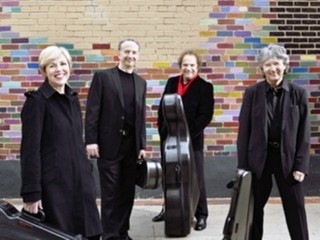|
Back
Takács in Love New York
Zankel Hall, Carnegie Hall
11/19/2015 - & November 22 (Louisville), December 2 (Ann Arbor), 4 (Boston) 2015
Josef Haydn: String Quartet in C Major, Opus 74, No. 1
Timo Andres: Strong Language (World premiere)
Antonín Dvorák : String Quartet No. 14 in A-flat Major, Opus 105
Takács Quartet: Edward Dusinberre, Károly Schranz (Violins), Geraldine Walther (Viola), András Fejér (Cello)

Takács Quartet (© Courtesy of the artists)
One of my three most memorable novels about classical composers is Josef Škvorecký’s Dvorák in Love. And last night’s recital by the Takács Quartet, including Dvorák’s last quartet, could have been titled Takács in Love. Whatever their previous performances of Brahms, Beethoven and Schubert, the selections last night showed a warmth, a delight, and a virtually physical reaching out to their audience.
The three composers–Haydn, Dvorák, and the Brooklyn-residing Timo Andres–each showed the music is its own emotion, that it needs no back-story or pictures to make its point. And that deft composition is its own reward.
That was obviously shown in Josef Haydn’s very late C Major String Quartet. Most of his quartets were written for private performances. But in London, a city he loved, this was for one of those newfangled public halls. Others might have shown off their work at this point, but Haydn was too classy–and at this point in his life, too successful–for such tricks.
Instead, we had a four-movement whose counterpoint was as virtuosic as Bach, yet one never thought about the methods. Instead, the Takács played this with a bold, spacious picture. Haydn involved all the instruments, yet one had to single out First Violin Edward Dusinberre in the opening movement for some splendid playing in the highest registers.
That Allegro, though, was followed by two extraordinary movements. The second was not the usual slow movement, but a gracious dance piece which could have been written by Rossini. Still, the movement had it sudden jolts in key–and Takács took them with insouciant leisure. There’s no need to “push” Haydn’s little pranks. They speak for themselves.
Nor was the Minuet simply an entr'acte. The central section was played with a sheer luminosity. The finale may have been a Haydn homage to Scotland with its bagpipe drones, but again, the Takács Quartet played the notes without hammering those folkish moments. Yes, cellist András Fejér gave a heavy bow to the open-string pedal points, but these only served as background for more sumptuous music. Music from a composer who felt so comfortable, so cheerful in a deftness honed to perfection over seven decades.
Takács, not known for its contemporary scores, gave the world premiere (co-commissioned by Carnegie Hall) to the 30-year-old Timo Andres, (who may have unnerved them for a second, saying how he had “grown up” to the Takács recordings). His own work, co-commissioned by Carnegie Hall, was another work that preluded 21st Century angst and produced an obvious joy of composition.
How joyful? The personable Mr. Andres introduced one “up-and-down” section not inspired by hills and valleys–but the piles of garbage in his neighborhood.
Yes, a tree may grow in Brooklyn. But rubbish can be equally inspiring.
His 25-minute Strong Language was minimalist in a certain way: he took three musical statements for three movements, developing them in a quirky, humorous but always invigorating manner. My own favorite was the opening Middens (which was happily not explained; it means a pile formed by rodents.) Each of the four Takács instruments played a melodic line which doubled back on itself. Sometimes it was canonic, sometimes solo with a few interruptions–and several times, it slowed down to a stasis of dissonant chords. Before returning to the original lines.
For one who finds rodents intriguing in their motions, it was a delight.
Origin Story starts with a static D Minor chord which reaches out further and further, and then, in a palindromic shift, goes back to the beginning. And finally, Gentle Cycling took the form of an 18th Century chaconne with violist and cellist Gerladine Walther and András Fejér playing the theme before they all returned to the start.
Were these three musical games? Possibly. But game theory doesn’t explain the enchantment one felt in the rules he made up, and how he followed (and broke) them.
The last half was devoted to Antonín Dvorák’s (probable) final quartet. After agonizing through an evening of Brahms quartets a few weeks ago and listening to Takács playing this Fourteenth Quartet, I understood why Schoenberg said that the Czech was superior.
“Brahms,” he said, “was a piano player. Dvorák was a string player. He knew how to write for strings.”
The Takács players knew this instinctively. Not because their native Hungary is in the general ethnic direction of the Czech Republic (there was little folk-quotation here), but because the sense of Dvorák compositional joy was present from first slow introduction to the final rich Allegro to be played “not too quickly.”
That brooding intro branched can become quite exuberant, but the Takács preferred a more refined, delicately textured sound, including a hunting-call which wouldn’t have scared off a rabbit!
The following dance was given a more active stance, and the slow movement, which can become laggard, was always on tempo.
For the finale, we began to understand that Dvorák’s sense of rhythm, dance and–above all–tuneful inspiration was second to nobody. The melodies took different turns, and it ended with sheer revelry.
Perhaps the only doleful part of the evening was exiting Zankel Hall into an awful storm. Bless these four players, though, while one wasn’t exactly singing in the rain, the resonance of their playing gentled a simple invigorating drenching.
Harry Rolnick
|